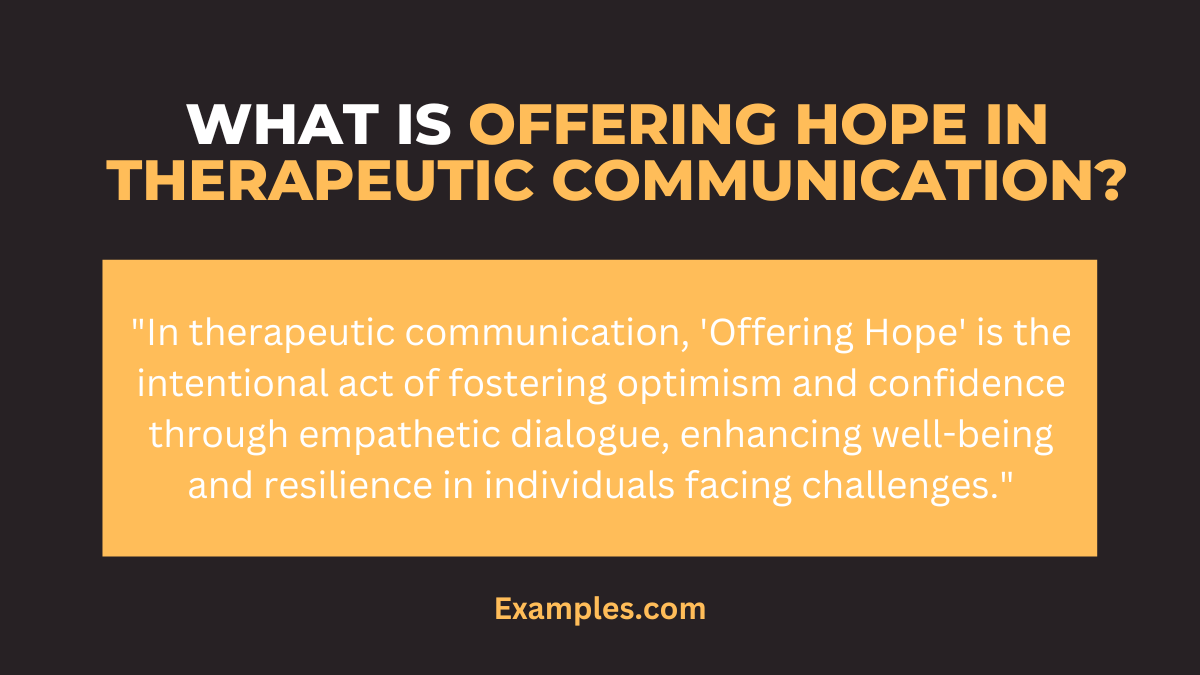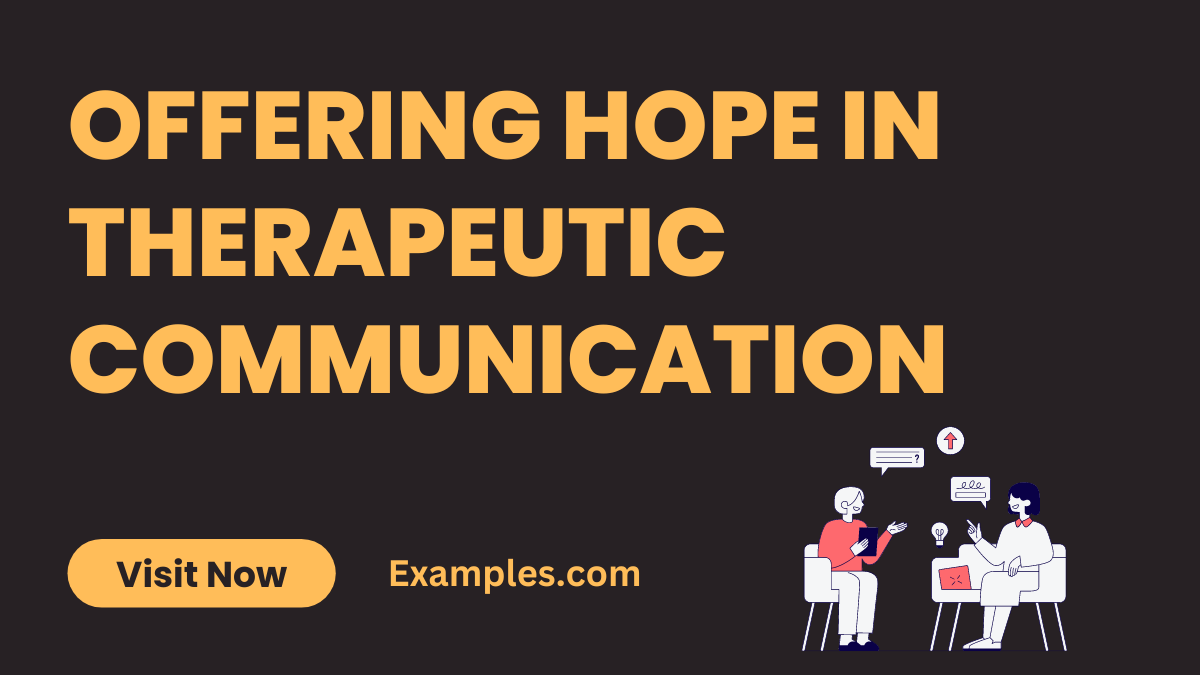19+ Offering Hope in Therapeutic Communication Examples
Embark on a transformative journey of therapeutic communication, delving into strategies that infuse hope into interactions. This guide illuminates the power of positive dialogues, providing insights, tips, and impactful Communication Examples. Learn how to foster an environment that uplifts, supports, and offers hope in every exchange. Elevate your communication skills and embrace the art of bringing optimism to therapeutic interactions.
What is Offering Hope in Therapeutic Communication?

In the realm of therapeutic communication, “Offering Hope” involves healthcare professionals fostering an optimistic and positive environment through dialogue. It encompasses using words, gestures, and empathetic approaches to instill confidence, uplift spirits, and inspire optimism in individuals facing challenges. In simpler terms, it’s the intentional act of infusing hope into conversations to enhance well-being, resilience, and the overall therapeutic experience.
What is the Best Example of Offering Hope in Therapeutic Communication?

In therapeutic communication, a powerful example of offering hope is through empathetic reassurance and encouragement. Healthcare professionals may say, “Despite the challenges, many patients have overcome similar situations. Your strength and resilience can lead to positive outcomes.” This statement acknowledges the difficulties, provides a relatable success story, and instills confidence, fostering a hopeful perspective. Such affirmations inspire individuals to see possibilities, reinforcing the therapeutic bond and promoting a positive outlook.
20 Offering Hope in Therapeutic Communication Examples

Explore these diverse examples designed to infuse hope into therapeutic communication, fostering positive and uplifting interactions.
- Empathetic Affirmations: “You’ve faced challenges before and emerged stronger. Your resilience is a source of hope for your journey ahead.”
- Shared Success Stories: “Others in similar situations have found hope. Let me share a story of triumph over adversity to inspire you.”
- Future Possibilities: “Consider the potential for positive change. Visualize a future filled with hope, growth, and renewed well-being.”
- Strength Acknowledgment: “Your inner strength is commendable. Recognizing your resilience is the first step towards a hopeful path.”
- Small Achievements: “Celebrate the small victories. Each step forward, no matter how small, contributes to a more hopeful future.”
- Affirming Progress: “Your progress is remarkable. Acknowledge your journey, and let it be a beacon of hope for what lies ahead.”
- Encouraging Self-Reflection: “Reflect on your inner resources. Discovering your innate strengths can be a wellspring of hope during challenging times.”
- Positive Visualization: “Envision a positive outcome. Imagining success can instill a sense of hope and motivation for the journey.”
- Promoting Self-Care: “Prioritize self-care. Nurturing your well-being is a powerful way to cultivate hope for a brighter tomorrow.”
- Expressing Belief: “I believe in your resilience. Together, we can navigate challenges and pave a hopeful path towards healing.”
- Cultivating Gratitude: “Find hope in gratitude. Reflecting on positive aspects can shift perspective and foster a more hopeful outlook.”
- Encouraging Support Networks: “Lean on your support system. Connecting with others can provide comfort and reinforce a sense of hope.”
- Fostering Mindfulness: “Practice mindfulness. Being present in the moment can bring a sense of peace and hope for the future.”
- Exploring Coping Strategies: “Let’s explore coping methods. Equipping yourself with effective strategies can be a beacon of hope in challenging times.”
- Recognizing Personal Growth: “Acknowledge your personal growth. Reflecting on how far you’ve come can ignite a flame of hope within.”
- Encouraging Future Planning: “Plan for the future. Setting goals and envisioning a positive outcome can fuel a sense of hope.”
- Utilizing Positive Affirmations: “Incorporate positive affirmations. Speaking hopeful words can shape your mindset and foster a more optimistic outlook.”
- Highlighting Resilient Role Models: “Consider resilient role models. Learning from those who’ve overcome challenges can inspire hope in your journey.”
- Celebrating Resilience: “Celebrate your resilience. Each challenge you overcome is a testament to your ability to find hope in adversity.”
- Creating Hopeful Rituals: “Establish hopeful rituals. Engaging in activities that bring joy can infuse your life with positivity and a sense of hope.”
Offering Hope in Therapeutic Communication For Clients Examples
Navigate therapeutic communication with clients using examples designed to instill hope and positivity. Elevate interactions, fostering resilience and inspiring a hopeful outlook.
- Expressing Optimism: Communicate a hopeful perspective, emphasizing positive aspects of the client’s situation to uplift spirits.
- Encouraging Future Vision: Help clients envision a hopeful future, emphasizing possibilities for growth and positive change.
- Recognizing Inner Strength: Acknowledge the client’s inner resilience, highlighting their ability to overcome challenges and find hope.
- Affirming Progress: Recognize and celebrate small victories and progress, reinforcing a sense of hope and achievement.
- Empathy and Understanding: Demonstrate empathy and understanding, fostering a connection that brings comfort and instills hope.
- Establishing Hopeful Goals: Collaborate with clients to set hopeful and achievable goals, creating a sense of purpose and optimism.
- Fostering Support Networks: Encourage clients to connect with supportive networks, promoting a sense of community and hope.
- Mindful Reflection: Guide clients in mindful reflection, helping them find hope in the present moment and positive aspects of their lives.
- Nurturing Self-Care: Emphasize the importance of self-care practices, empowering clients to prioritize their well-being and cultivate hope.
- Affirmative Affection: Express care and positive regard for clients, creating an atmosphere of acceptance and fostering a hopeful outlook.
Offering Hope in Therapeutic Communication in Healthcare Examples
Explore healthcare-focused examples of providing broad openings in therapeutic communication. Enhance patient-provider interactions, promoting open and supportive dialogues.
- Establishing Trust: Initiate conversations with a focus on building trust, creating a foundation for open communication in healthcare settings.
- Encouraging Patient Narratives: Invite patients to share their experiences and stories, fostering a sense of agency and openness in healthcare dialogues.
- Clarifying Expectations: Set clear expectations for communication, ensuring patients feel comfortable expressing their thoughts and concerns.
- Validating Emotions: Acknowledge and validate patients’ emotions, creating a space where feelings are recognized and understood.
- Embracing Cultural Sensitivity: Approach conversations with cultural sensitivity, acknowledging diverse perspectives and fostering inclusive healthcare communication.
- Providing Information Options: Offer patients choices in receiving information, empowering them to be active participants in their healthcare journey.
- Addressing Anxiety: Gently address patients’ anxieties by providing broad openings for them to express concerns and uncertainties.
- Facilitating Family Involvement: Encourage family involvement in healthcare discussions, creating a supportive network for patients.
- Eliciting Patient Preferences: Seek patient preferences in communication styles, tailoring interactions to their comfort and fostering open dialogue.
- Anticipating Questions: Proactively address potential questions, demonstrating attentiveness and creating a space for comprehensive healthcare discussions.
How do you encourage Offering Hope in Therapeutic Communication?
Therapeutic communication infused with hope is a transformative practice. Learn how to foster a culture of optimism and resilience in your interactions with these comprehensive steps:
- Start with Empathy: Begin conversations by genuinely understanding and acknowledging the emotional state of the individual, creating a foundation for hopeful dialogue.
- Use Positive Language: Employ uplifting and positive language that resonates with the individual’s emotions, framing discussions in a hopeful context.
- Share Success Stories: Incorporate relevant success stories to inspire hope, demonstrating that positive outcomes are achievable and attainable.
- Acknowledge Strengths: Recognize and highlight the strengths of the individual, fostering a sense of empowerment and self-belief.
- Set Realistic Goals: Collaborate on setting achievable goals, providing a roadmap for progress and instilling hope in the journey ahead.
- Encourage Expressive Arts: Explore creative outlets like art or writing to express emotions, offering a therapeutic avenue for fostering hope.
- Promote Mindfulness Practices: Introduce mindfulness techniques to help individuals stay present, reducing anxiety and creating a hopeful mindset.
- Involve Support Networks: Encourage connections with supportive friends, family, or groups, reinforcing a sense of community and shared hope.
- Celebrate Small Wins: Acknowledge and celebrate small achievements along the way, reinforcing a positive narrative and cultivating hope.
- Provide Resources: Share relevant resources, such as literature or educational materials, to empower individuals with knowledge and promote hope.
What are the important factors in Offering Hope in Therapeutic Communication?
In the realm of therapeutic communication, infusing hope is a powerful and transformative practice. Here’s a detailed guide highlighting essential factors to effectively offer hope in therapeutic interactions:
- Empathetic Presence: Cultivate a compassionate and understanding demeanor, demonstrating genuine empathy for the individual’s experiences.
- Positive Framing: Frame discussions with a positive and optimistic tone, focusing on strengths, achievements, and potential for positive outcomes.
- Active Listening: Engage in active listening to comprehend and acknowledge the individual’s feelings, fostering a sense of being heard and understood.
- Promoting Self-Efficacy: Encourage a belief in one’s ability to navigate challenges, emphasizing personal strengths and resilience.
- Respecting Autonomy: Acknowledge and respect the individual’s autonomy, empowering them to actively participate in decision-making regarding their well-being.
- Sharing Success Stories: Illustrate examples of others who have overcome similar challenges, providing real-life narratives that inspire hope.
- Encouraging Future Planning: Collaborate on setting achievable goals, fostering a sense of purpose and direction for the future.
- Instilling Optimism: Foster a hopeful outlook by focusing on positive aspects, potential for growth, and the capacity for change.
- Cultivating a Supportive Environment: Create a safe and supportive space where individuals feel comfortable expressing themselves without judgment.
- Highlighting Resources: Inform individuals about available resources, support networks, and coping mechanisms, facilitating a sense of security and hope.
In conclusion, this guide to offering hope in therapeutic communication provides a roadmap for fostering positive connections. Through empathetic communication, active listening, and the infusion of optimism, individuals can find solace and encouragement. By celebrating achievements and sharing inspirational examples, this comprehensive guide empowers both practitioners and clients to navigate challenges with a renewed sense of hope and resilience.



